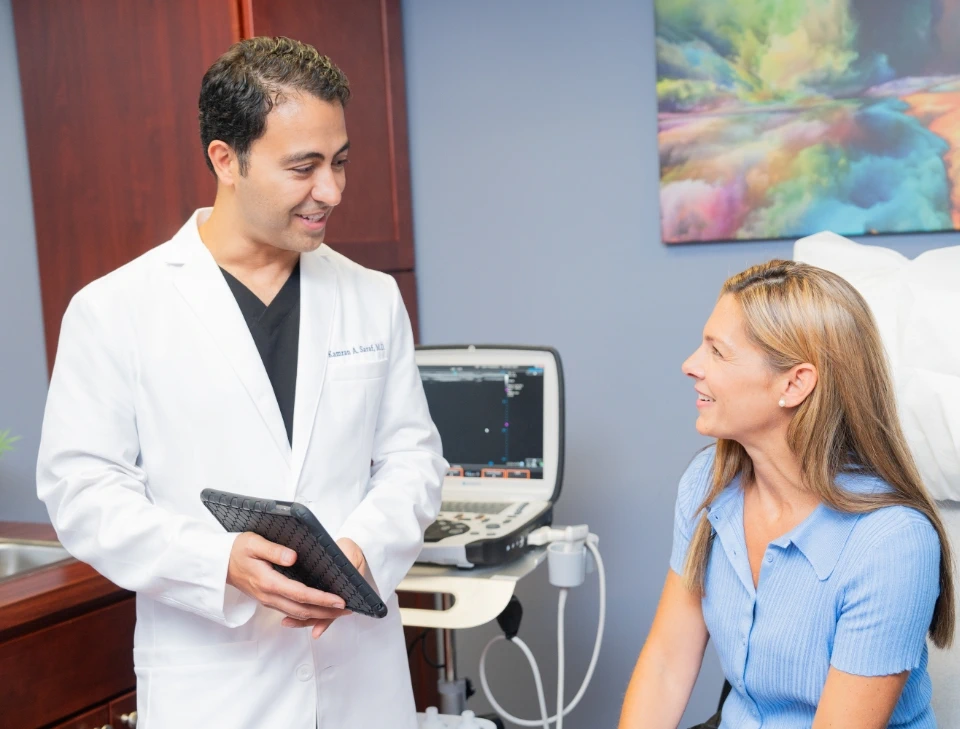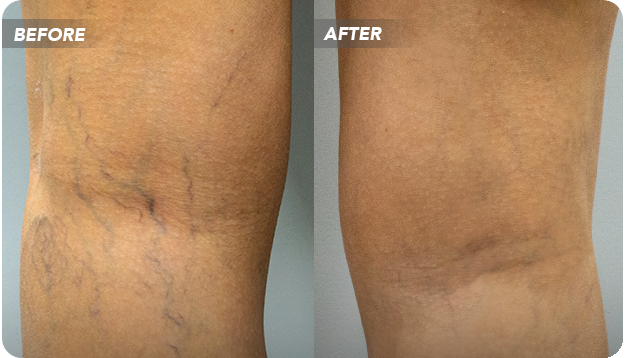Step 1: Booking an Appointment
If you’re reading this guide to spider vein treatment in Suffolk County, you’re probably looking for a vein clinic, or you’ve already scheduled your spider vein treatment. If you haven’t yet scheduled your treatment, we encourage you to consult our vein doctors in Suffolk County. Vein Treatment Clinic is widely considered the most reliable vein clinic in Long Island, with an office conveniently located at 481 W Montauk Highway, right on the border of Suffolk County and Nassau County. You may schedule an appointment to proceed with your spider vein treatment.
Step 2: Initial Consultation
During your initial consultation, our vein doctor will discuss your symptoms, goals, and expectations. They’ll ask you to describe all your symptoms, such as leg heaviness, restless leg syndrome, leg swelling, leg pain, throbbing leg veins, frequent leg cramps, etc. The vein specialist will also examine your spider veins to look for other potential vein diseases. Finally, they’ll review your medical history and discuss your family history, i.e., if you (or someone in your family) has a history of vein disease or blood clots in the veins.

The aforementioned evaluations identify the likelihood of chronic venous insufficiency, the root cause of most vein diseases. Venous insufficiency is a medical condition wherein the collapse of your vein valves makes blood flow backward and accumulate in your leg veins. As more blood pools in your leg veins, the increased pressure makes your vein walls dilate and expand outwards, leading to spider veins and varicose veins. If left untreated, vein disease can also cause leg ulcers, deep vein thrombosis, and other complications.
Step 3: Vascular Imaging
After the initial evaluation, the vein doctor will use advanced vascular imaging tests, such as duplex ultrasound, to determine if you truly have underlying vein disease. During the test, an ultrasound device will visualize the blood flow in your leg veins on a computer screen. This helps the vein specialist determine if you have vein disease and identify the saphenous vein responsible for your vein problems. Vascular imaging is essential to curate the ideal vein treatment plan for your specific needs.

Step 4: Treatment Planning
The vascular imaging is followed by a comprehensive treatment planning process. The vein doctor will describe all the potential minimally invasive treatments for your specific needs. They’ll curate your treatment plans based on your diagnosis, symptoms, cosmetic goals, medical history, allergies, and other factors. They’ll also discuss your insurance coverage options, treatment costs, and lifestyle factors to curate the ideal treatment for you. Finally, the vein physician will describe every step of the vein treatment process.
Step 5: Primary Vein Treatment
The primary vein treatment is only meant for patients with underlying chronic venous insufficiency, as seen through vascular imaging. If you don’t have underlying vein disease, the vein doctor will simply move to the next step. However, if you have venous insufficiency, it’s essential to treat the diseased vein before addressing the spider veins. If you treat spider veins without addressing the root cause, the spider veins will simply return. The suitable minimally invasive treatments include radiofrequency ablation, laser ablation, mechanochemical ablation, and vein glue treatment.
The following is an overview of the possible vein treatments for underlying venous insufficiency:
- Endovenous Radiofrequency Ablation: The vein doctor inserts a catheter through a small incision on the skin’s surface to deliver thermal energy into the diseased vein. The diseased vein is destroyed, and the accumulated blood reroutes to healthier veins.
- Endovenous Laser Ablation: The vein doctor inserts a laser fiber through a small incision on the skin’s surface to deliver laser energy into the problematic vein. The diseased vein is destroyed, and the accumulated blood flows into healthier leg veins.
- Mechanochemical Ablation (ClariVein): The vein doctor inserts a specialized catheter with a rotating tip into the diseased vein. The catheter scratches the diseased vein’s walls and delivers a sclerosant solution, turning it into hardened scar tissue.
- Vein Glue Treatment (VenaSeal): The vein doctor injects a medical-grade adhesive (vein glue) into the diseased saphenous vein. The vein glue fuses the diseased vein’s walls, turning it into a hardened scar tissue eventually absorbed by the body.
Step 6: Spider Vein Treatment
The spider vein treatment is suitable for patients without underlying vein disease or after the primary vein treatment. The spider vein treatment is a cosmetic procedure, i.e., it focuses on removing the visible spider veins (and superficial varicose veins) without addressing the root cause. The spider vein treatment options include sclerotherapy, laser vein treatment, and ambulatory phlebectomy.
The following is an overview of the possible minimally invasive treatments for spider vein and varicose vein removal:
- Laser Vein Treatment: The vein doctor uses a handheld laser device to deliver laser energy into the spider veins. This is a non-invasive procedure wherein the laser energy heats the spider veins’ walls, making them shrink and fade away. However, it’s not very effective.
- Sclerotherapy: The vein doctor injects a sclerosant solution into the individual spider veins. The sclerosant solution irritates the spider veins, making them shrink and fade away from the skin’s surface.
- Ambulatory Phlebectomy: The vein doctor physically extracts the superficial varicose veins through small incisions on the skin’s surface. The incision marks gradually fade away.
Step 7: Recovery & Aftercare
All minimally invasive treatments for spider veins and varicose veins conclude within an hour with no downtime. You may experience mild soreness, discomfort, or irritation around the treatment sites, but you can resume your daily activities immediately. Your vein doctor will discuss post-treatment recovery guidelines, such as wearing compression stockings, following which you can leave the vein clinic in Suffolk County.
To learn more about the different options for spider and varicose vein treatment, please visit https://www.veintreatmentclinic.com/vein-treatment/. Our accredited vein centers offer all of the latest technology, and our accomplished and compassionate vein experts will create a custom treatment plan tailored to your individual needs. We have locations in New York, Long Island, New Jersey, California, and Texas.









